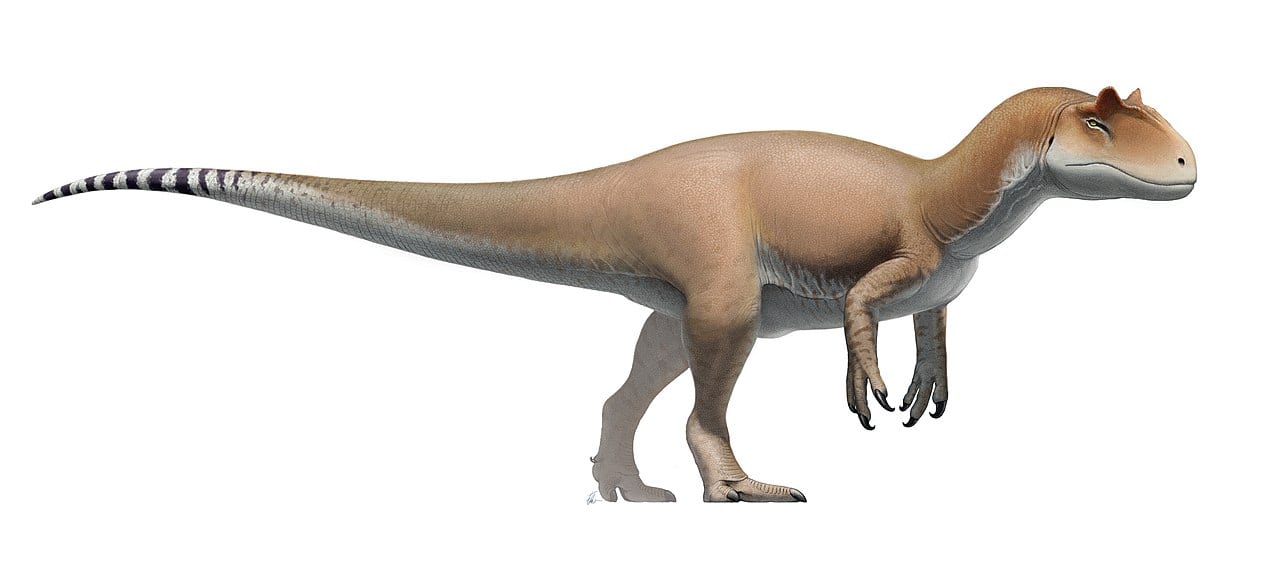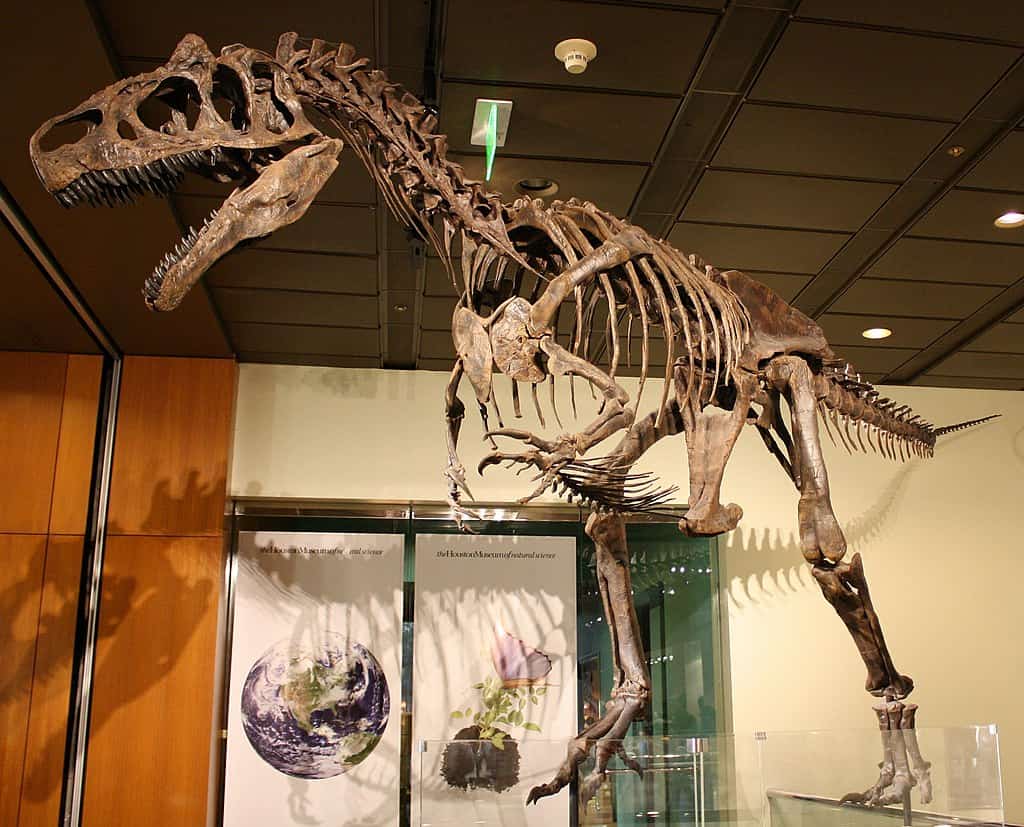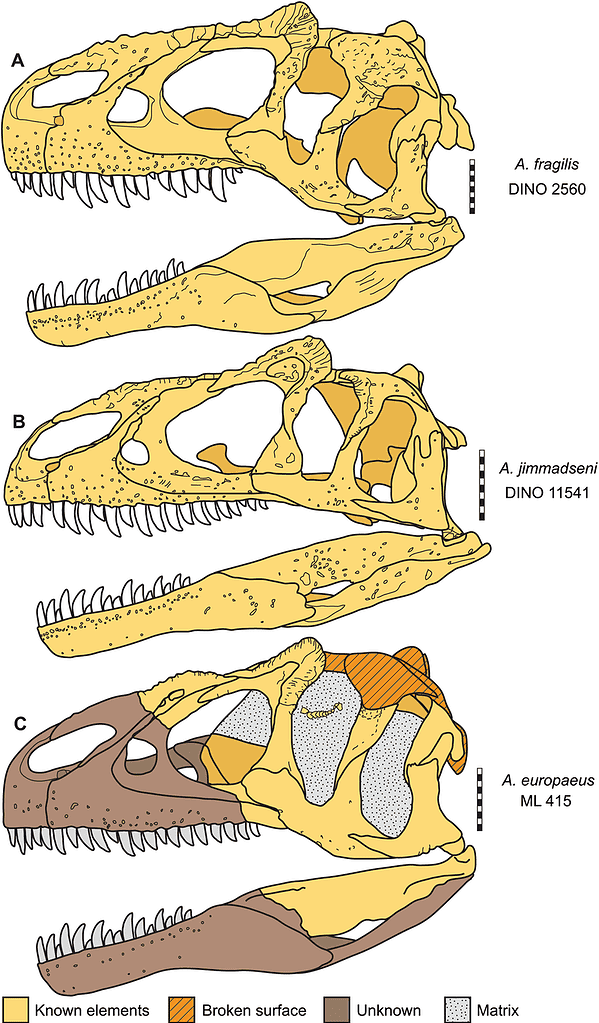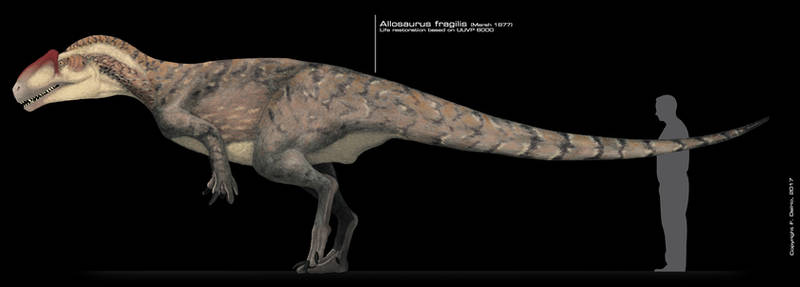
Allosaurus was a massive dinosaur that lived 155 to 145 million years ago during the Late Jurassic period. It was a fierce predator with a massive skull and razor-sharp teeth. Allosaurus measured, on average, 8.5 m (28 ft) and weighed around 1.7 metric tons, although it could get even bigger, up to 2.3 tons. It was an apex predator on top of the food chain — but that’s just one part of what makes it so awesome.
Meet the Beast
Jurassic Park featured several dinosaurs, including T-Rex, velociraptors, and triceratops. But those aren’t true Jurassic dinosaurs — they lived in the Cretaceous, millions of years after the Jurassic. If you want to see a quintessential Jurassic dinosaur, that’s the Allosaurus.
But there’s still much we don’t know about it.

The name “Allosaurus” means “different lizard” or “strange lizard”. This comes from its unique (at the time of its discovery) concave vertebrae. But there are plenty of other things about Allosaurus that are strange.
What Allosaurus looked like

There are at least three valid Allosaurus species, but the genus has a very complicated taxonomy and researchers aren’t certain how to classify all the findings. However, all allosaurus species shared some similarities.
It had powerful limbs and a slightly sloping tail. It was built for speed, and according to studies, it would have reached speeds of up to 21 miles per hour (34 km/h). This was faster than other dinosaurs of its time, including the Sauropods and Stegosaurs it hunted. For comparison, the top human speed ever reached is around 37 km/h for 100 meters. Olympic sprinters would have been able to outrun Allosaurus — but most of us had slim chances.
Its arms, though shorter than its legs, were no less terrifying. Imagine a clawed hand at the end of a muscular arm, each claw as long as a human hand. Each fingred hand had three large, curved claws. These arms were not just for show; they allowed Allosaurus to cling to prey.

A Tail with a Purpose
The Allosaurus’ tail was not just an accessory. It was a finely tuned instrument that provided balance and stability. Picture a tightrope walker’s pole, offering the perfect counterbalance to the massive head and body. This tail allowed the Allosaurus to make rapid turns and adjustments while in full sprint, turning what could be a clumsy run into a graceful and lethal pursuit.
This is why researchers believe Allosaurus wouldn’t have only scavenged. It would have hunted too. However, its bite would have been remarkably weak for a dinosaur this size, which doesn’t hint at only hunting.
Skull and Dentition

The skull of Allosaurus was proportionately large and equipped with dozens of sharp, serrated teeth, perfect for tearing into flesh. Unlike other theropods, its skull combined strength with lightness, an adaptation likely evolved for handling large, struggling prey.
One of the most striking features of Allosaurus was its pair of short bony crests above its eyes. Formed by extensions of the lacrimal bones, it is speculated that they might have served for display and thermoregulation.
Brain and Senses
Though we can’t know for sure, some scientists believe that Allosaurus might have been covered in scales or even primitive feathers.
The dinosaur’s brain resembles that of crocodiles. Researchers used CT scans to study this in great detail. The structure of the inner ear also resembled that of crocodiles, so they could have only heard lower frequency sounds and would have had problems hearing sharper sounds.

Their sense of smell had an interesting dichotomy. The area for detecting odors was very well developed. But the area for interpreting smells was less developed. So the dinosaur would have been able to pick up smells very keenly. It wouldn’t have known exactly what they are, but it would have picked them up.
Allosaurus habitat and lifestyle
When Allosaurus was king of the land, the world was a different place. Not only did it look differently, but it also had different temperatures and vegetation.
During the time of the Allosaurus, the supercontinent Pangaea was breaking apart. Imagine a colossal puzzle, slowly coming undone. This was a world in transition, where the very ground beneath the feet of the Allosaurus was shifting and changing.
These tectonic movements gave birth to new ecosystems and climates, shaping the world into something both familiar and alien.
You wouldn’t find icy polar caps in Allosaurus’s world. Instead, picture a warm and wet climate, where seasonal monsoons washed the land and nourished the verdant flora. Think of a tropical paradise, but on a grand, prehistoric scale.
Roaming the lands of what is now North America and Portugal, Allosaurus wasn’t a picky eater. From smaller plant-eating dinosaurs to even its kin, it hunted with an opportunistic flair.
As a likely apex predator, it probably hunted large herbivorous dinosaurs using ambush attack tactics. There is ongoing debate among scientists about whether Allosaurus hunted in packs or as solitary predators. Evidence of healed injuries in fossil specimens indicates that Allosaurus led a life filled with physical confrontations, either with prey or with other predators, including conspecifics.
Alongside Allosaurus, you would not only find terrifying predators but also a wide array of plant-eating dinosaurs like Stegosaurus and Diplodocus. It was a world where gentle giants grazed beside armored warriors, and swift runners darted between the shadows.
Pterosaurs ruled the skies, their wings casting fleeting shadows over the landscape, while in the water, large fish and crocodile-like reptiles lurked.
It was a strikingly different world from ours, but a very diverse one.
Allosaurus Taxonomy and Species
The genus Allosaurus encompasses several species. Its taxonomy is both rich and complex, revealing a genus with varied yet closely related species.
Allosaurus is classified under the family Allosauridae, within the clade Theropoda. This classification places it among the large carnivorous dinosaurs, distinguished by their bipedal stance and predominantly meat-based diet.
Allosaurus fragilis
Allosaurus fragilis, the most extensively studied species, was a true icon of the Jurassic. It was discovered by Othniel Charles Marsh in 1877. Measuring up to 12 meters (39 feet) in length and weighing as much as 2.3 metric tons, A. fragilis was a formidable predator. It had a massive skull armed with sharp, serrated teeth and powerful jaws capable of delivering lethal bites to its prey.
Allosaurus europaeus
A relatively recent addition to the Allosaurus family is Allosaurus europaeus, discovered in Portugal. This species was slightly smaller than A. fragilis but shared many anatomical similarities. Its discovery in Europe was a significant piece of the puzzle, indicating that Allosaurus was not confined to North America but had a much broader geographic range.
Allosaurus jimmadseni
The latest species to join the Allosaurus genus is Allosaurus jimmadseni, identified from fossils found in the western United States. This species, dating back to the earlier part of the Late Jurassic, offers new insights into the evolutionary history of Allosaurus. A. jimmadseni is distinguished by its unique cranial features, including a more delicate and ornate skull compared to its relatives.
The discovery of various Allosaurus species has offered valuable insights into the evolutionary pathways of large theropods. Differences in skull morphology, limb proportions, and size among these species suggest a degree of niche differentiation and adaptive radiation within this genus.
Did Allosaurus hunt or scavange?
Paleontological evidence for Allosaurus (fossils) mostly comes from North America, but other fossils were also found in Portugal. Allosaurus was fast and strong, and it seemed to prefer dry floodplains, where it could hunt freely. But like with T-Rex, there’s some controversy as to whether it only hunted or scavenged.
A 2021 paper suggested that the dinosaur may have got more calories from scavenging. This is recent research and is still far from settled. “This new perspective may overturn 150 years of established thought,” said author Cameron Pahl at Portland State University. In fact, Pahl goes as far as to mention that Allosaurus may have been the dinosaur equivalent of a vulture.
“Our results may explain why carnosaurs like Allosaurus did not evolve powerful bite forces, binocular vision, or advanced cursorial adaptations. Given the enormous supply of sauropod carrion, they were under no resource-based selective pressure to overpower prey and may have evolved as terrestrial vulture analogues,” the study reads.
Hunting in Packs?
Some paleontologists believe that Allosaurus might have hunted in packs, coordinating their attacks much like wolves do today. Imagine a group of these giants, working together, communicating with body language and positioning. Few things would have been as terrifying.
However other researchers believe individuals may have been aggressive toward each other and the only reason why lone individuals would congregate is to feed on the same carcasses.
In fact, they wouldn’t have even shied away from cannibalism.
“Scavenging, and even cannibalism, is pretty common among modern predators,” said Stephanie Drumheller, a paleontologist in the University of Tennessee, Knoxville’s Department of Earth and Planetary Sciences, and lead author of a study on Allosaurs. Big theropods, like Allosaurus, probably weren’t particularly picky eaters if it meant they got a free meal.
However, this is still a subject of debate, and the solitary, stalking hunter remains a prominent image of the Allosaurus — although it may not be entirely true.
Discovery and early research
The saga of Allosaurus’ discovery begins in the late 19th century, a period marked by intense and often competitive fossil hunting known as the “Bone Wars.” It was during this era of scientific rivalry that the first bones of Allosaurus were unearthed, setting the stage for a series of discoveries that would bring this prehistoric predator to light.
In 1877, the renowned paleontologist Othniel Charles Marsh played a pivotal role in the formal scientific recognition of Allosaurus. Marsh, who was deeply engaged in the “Bone Wars” against his rival Edward Drinker Cope, described and named Allosaurus based on fragmentary remains. Marsh’s description came from material that included parts of vertebrae and limb bones, painting the first picture of this magnificent beast.
The name Allosaurus translates to “Different lizard”.

The Impact of the Bone Wars
The Bone Wars, a period of intense and often acrimonious rivalry between Marsh and Cope, drove both men to unearth numerous dinosaur fossils, including those of Allosaurus. Their competition, while contentious, spurred significant advancements in the field of paleontology. However, it also led to a confusing multiplicity of names and classifications for the same dinosaurs, a challenge that later researchers would strive to resolve.
Initially, there were misconceptions and errors in the classification of Allosaurus, comm
New research on Allosaurus
How do we know all this? Through the hard work of paleontologists, who dig into the very bones of the Earth, unveiling the secrets buried for millions of years. They piece together the Allosaurus’s world, one fossil at a time, much like assembling a jigsaw puzzle.
New species of Allosaurus are also routinely being discovered. For instance, Allosaurus jimmadseni was only described in 2020.
“Previously, paleontologists thought there was only one species of Allosaurus in Jurassic North America, but this study shows there were two species–the newly described Allosaurus jimmadseni evolved at least 5 million years earlier than its younger cousin, Allosaurus fragilis,” said co-lead author Mark Loewen, research associate at the Natural History Museum of Utah, and associate professor in the Department of Geology and Geophysics at the University of Utah led the study. “The skull of Allosaurus jimmadseni is more lightly built than its later relative Allosaurus fragilis, suggesting a different feeding behavior between the two.”
“Recognizing a new species of dinosaur in rocks that have been intensely investigated for over 150 years is an outstanding experience of discovery. Allosaurus jimmadseni is a great example of just how much more we have to learn about the world of dinosaurs. Many more exciting fossils await discovery in the Jurassic rocks of the American West,” said Daniel Chure, retired paleontologist at Dinosaur National Monument and co-lead author of the study.

Allosaurus facts
- Name Meaning: “Allosaurus” translates to “different lizard,” derived from the Greek words “allos” meaning different, and “sauros” meaning lizard.
- Period: Allosaurus lived during the Late Jurassic period, approximately 155 to 145 million years ago.
- Size: Adult Allosaurus typically measured around 28 to 40 feet (8.5 to 12 meters) in length and weighed 2 to 3 tons.
- Diet: It was a carnivorous predator, feeding primarily on large herbivorous dinosaurs of the time, such as Stegosaurus and Apatosaurus.
- Teeth: Allosaurus had large, sharp teeth designed for cutting flesh, and it could replace these teeth rapidly as they wore down or broke off.
- Hunting Tactics: Some paleontologists believe Allosaurus hunted in packs or familial groups, although this is still debated. Some studies suggest it was a scavenger.
- Location: Fossils have been found primarily in the Morrison Formation of North America, but there are also specimens from Portugal and possibly Tanzania.
- Arms: Though smaller in comparison to the rest of its body, the arms of an Allosaurus were quite powerful and ended with three sharp claws.
- Discovery: The first scientifically recognized remains were discovered in 1877 by Othniel Charles Marsh in the western United States.
- Classification: Allosaurus belongs to the Theropoda group, specifically within the family Allosauridae.
- Significance: It is one of the most well-known and extensively studied of all dinosaurs, with dozens of complete or partial specimens.
- Extinction: Like many dinosaurs, Allosaurus likely became extinct due to a combination of environmental changes and competition from other predators.
- Cultural Impact: Allosaurus has appeared in numerous documentaries, films, and exhibits, solidifying its status as one of the iconic dinosaurs.
Allosaurus FAQ
A: “Allosaurus” translates to “different lizard.” The name refers to the unique structure of its vertebrae and other bones.
A: Allosaurus lived during the Late Jurassic period, around 155 to 145 million years ago. Its fossils have been primarily found in the Morrison Formation of North America, but also in Portugal and possibly Tanzania.
A: Adult Allosaurus typically measured around 28 to 40 feet (8.5 to 12 meters) in length and weighed 2 to 3 tons.
A: Allosaurus was a carnivore, preying on large herbivorous dinosaurs such as Stegosaurus and Apatosaurus, and possibly scavenging as well. This is still a matter of active research.
A: Though precise speeds are hard to estimate, Allosaurus was likely a relatively fast runner for its size.
A: The first scientifically recognized Allosaurus remains were discovered in 1877 by Othniel Charles Marsh in the western United States.
A: Yes, there are several recognized species of Allosaurus, with the best-known being Allosaurus fragilis.
A: Allosaurus likely went extinct due to a combination of environmental changes and competition from other predators. Its extinction was part of a broader pattern of changes in the Late Jurassic ecosystem.
A: Allosaurus was smaller than some later predatory dinosaurs like Tyrannosaurus rex but was still one of the dominant predators of its time. Its unique features, such as the hinged jaw and serrated teeth, set it apart from other theropods.
A: Despite being relatively short, Allosaurus’s arms were robust and had three sharp claws. While they were not the primary tool for hunting, they may have been used to grasp prey or deliver slashing wounds.
A: The evidence for pack hunting in Allosaurus is inconclusive. Some paleontologists believe that they may have hunted in familial groups or loosely organized packs, while others argue that they were solitary predators.
A: Allosaurus was one of the top predators in its ecosystem, but it likely shared its habitat with other large carnivorous dinosaurs like Ceratosaurus. The competition and hierarchy among these predators are still subjects of research.
A: While both were large carnivorous theropods, Allosaurus lived during the Late Jurassic, while T. rex lived during the Late Cretaceous, millions of years later. Allosaurus was generally smaller, with a lighter build and different jaw and teeth structures.
A: Allosaurus skeletons are displayed in many major natural history museums around the world, including the American Museum of Natural History in New York and the Natural History Museum in London.
A Never-Ending Exploration
While we have learned much, the story of Allosaurus is far from complete. Every year, researchers are learning new things about dinosaurs. You are now part of this exploration. Every time you gaze at a fossil in a museum or watch a film where this magnificent creature comes to life, you step into its world.
With new discoveries emerging, who knows what secrets still lie buried, waiting for the right hands to unearth them?


